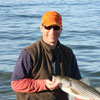Modified Catch and Release Fishing Best Practices
By Tom Keer
Nov 16, 2016
These days, catch and release fishing is as common as sunburn. But what if you want to keep a fish for dinner?
Hindsight is always 20-20, and that's what a lot of the beach rats said in the 1980's. Their 1940's, 1950's, and 1960's were such that if you didn't catch a lot of big fish while shore fishing you were a terrible fisherman. There were lots of stripers back then, and big ones were the norm. Some trophies were mounted while others were shared with family and friends. So many fish were around that no one could have predicted a collapse, but that's just what happened.
Lots of pictures from that time, and earlier too, show fishermen with long, fully loaded stringers. I don't begrudge them at all, but a part of me wishes I was fishing back then. I enjoy eating fish, too, but truth be told I prefer red meat. My doctor said I've got to lay off the steaks for my cholesterol is too high. And like many Americans, fish it is. Some thoughts on catch and release best practices and how we can have quality fishing with an occasional fish for dinner.
1. Despite what some may say, there is nothing wrong with keeping fish to eat.
2. Maintaining a balance of fishing for keeps and catch and release fishing is a great way to maintain fish stocks.
3. A good rule of thumb is limit your kill, don't kill your limit.
4. Protect your broodstock. We all like to show off trophy fish, but with digital cameras we can capture the moment while releasing a breeder to spawn another day.
5. A collective approach has a greater impact. Including your friends in the keep/catch and release best practices has a bigger affect than if you're the only one following the method.
6. Just releasing a fish isn't enough. Some fish, like tuna, bonito, and false albacore need to be jump started (or thrown headfirst into the water). Others, like trout or bass, need to be revived. Use the correct method for your specific fish.
7. Tools of the trade are important. Bogagrips are the best method for toothy fish while nets with soft, rubber-coated baskets are preferable for fish with protective coatings like trout.
8. Clean water and healthy environments are essential. Picking up trash, keeping boat gas and oil out of the water, using eco-friendly bottom paint, and picking up used soft plastics is part of the process. Stream or beach cleanups are awesome, and the Sport Fish Restoration program works.
Keeping fish to eat is cool. Practicing catch and release is essential.
Lots of pictures from that time, and earlier too, show fishermen with long, fully loaded stringers. I don't begrudge them at all, but a part of me wishes I was fishing back then. I enjoy eating fish, too, but truth be told I prefer red meat. My doctor said I've got to lay off the steaks for my cholesterol is too high. And like many Americans, fish it is. Some thoughts on catch and release best practices and how we can have quality fishing with an occasional fish for dinner.
1. Despite what some may say, there is nothing wrong with keeping fish to eat.
2. Maintaining a balance of fishing for keeps and catch and release fishing is a great way to maintain fish stocks.
3. A good rule of thumb is limit your kill, don't kill your limit.
4. Protect your broodstock. We all like to show off trophy fish, but with digital cameras we can capture the moment while releasing a breeder to spawn another day.
5. A collective approach has a greater impact. Including your friends in the keep/catch and release best practices has a bigger affect than if you're the only one following the method.
6. Just releasing a fish isn't enough. Some fish, like tuna, bonito, and false albacore need to be jump started (or thrown headfirst into the water). Others, like trout or bass, need to be revived. Use the correct method for your specific fish.
7. Tools of the trade are important. Bogagrips are the best method for toothy fish while nets with soft, rubber-coated baskets are preferable for fish with protective coatings like trout.
8. Clean water and healthy environments are essential. Picking up trash, keeping boat gas and oil out of the water, using eco-friendly bottom paint, and picking up used soft plastics is part of the process. Stream or beach cleanups are awesome, and the Sport Fish Restoration program works.
Keeping fish to eat is cool. Practicing catch and release is essential.
Popular Posts









